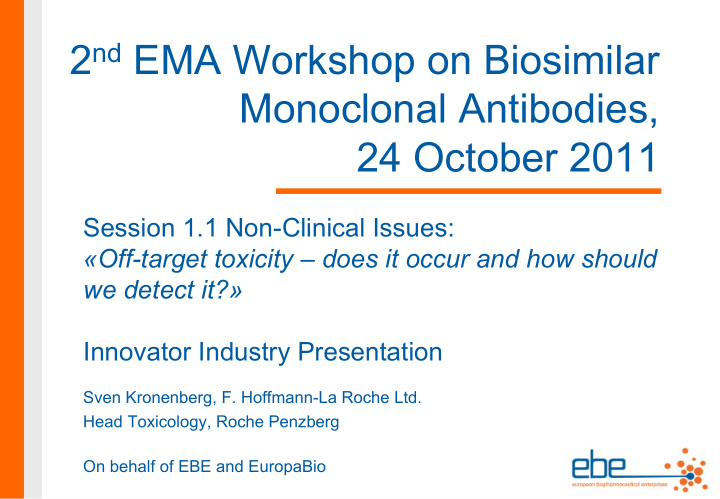



2 nd EMA Workshop on Biosimilar Monoclonal Antibodies, 24 October 2011 Session 1.1 Non-Clinical Issues: «Off-target toxicity – does it occur and how should we detect it?» Innovator Industry Presentation Sven Kronenberg, F. Hoffmann-La Roche Ltd. Head Toxicology, Roche Penzberg On behalf of EBE and EuropaBio
Unexpected in-vivo findings Cases of “off-target” findings with mAbs have been published. Since cause may involve MoA, CDR/Fc characteristics and/or product attributes, the broader term “ unexpected in-vivo findings ” is used here In-vivo assessment for potential unpredicted effects is an important part of non-clinical safety testing Unexpected binding, not detected by in-vitro testing, can significantly affect the in-vivo behaviour and toxicity of a mAb In-vitro assays will only address the known, but not the unknown For addressing unexpected in-vivo findings, the following should be considered Reference to ICH S6 R(1) (slide 3) Case example (slide 4 ) 2
In-vivo studies to be considered to address potential for unexpected effects as per ICH S6 R(1): Section 2.1 The text below was included in ICH S6 R(1) to address the potential for unexpected in-vivo effects with products directed at exogenous targets This approach is considered appropriate to support entry of biosimilar products into the clinic The choice of relevant species should be justified by the sponsor 3
Unexpected in-vivo findings – Case mAb Y Antibody mAb Y – Target expression is highly restricted Finding: rapid profound thrombocytopenia ; mild to marked decreases in red cell mass, after a single dose at ≥ 50 mg/kg via SC or IV route. After 40hrs, platelet decreased 92-99% from pretest (absolute counts 4-50x10e3/ul). At 72 hours, increased numbers of activated macrophages , some with mitotic figures, and macrophages with phagocytized erythrocytes in the spleen. No detectable binding of mAb-Y to cynomolgus peripheral blood or bone marrow cells in-vitro. In-vitro, mAb-Y induced cynomolgus peripheral blood monocytes ( PBMs ), but not human PBMs, to phagocytize platelets. The F(ab)’2 portion of the molecule did not induce phagocytosis of platelets. Three mAbs sharing the same Fc framework as mAb-Y competitively bound to and had similar biological activity against the intended target. None of these antibodies had the haematologic liability in-vitro or in-vivo. Modification of the Fc portion of mAb-Y to decrease FcR binding attenuated the in- vivo and eliminated the in-vitro hematologic responses. Together, data demonstrate that the haematologic effects of mAb-Y in cynomolgus monkeys occurred through an mechanism involving both the Fc and CDR portions of this specific monoclonal Ab. 4 Example provided by Ian Pyrah, Amgen
Unpredicted in-vivo findings - Summary 5
• BACKUP 6
Unexpected in-vivo findings – Case AMGX AMGX (IgG2), used to treat autoimmune and inflammatory diseases Finding: After 1 st dose, “rapid profound thrombocytopenia with decreased platelet granularity, lowered mean arterial pressure, and transient loss of consciousness and flushing” after a single dose in monkeys. Not seen with 3 other mAbs against same target . Platelet counts at 15 minutes after dosing were decreased 90-98% from pretest; less after subsequent doses; no ADAs, complement, nor vasculitis involved. Subsequent in vitro tests revealed activation and aggregation of platelets in macaque monkey species, but not for baboon or human platelets (not seen for the other 3 mAbs). Intact AMGX with Fc and CDR domains required (F(ab) 2 didn’t cause it). Preincubation of AMGX with the intended target eliminated platelet activation. Data support that activation of macaque platelets requires binding of AMGX by the Fc portion to the FcgRIIa receptor and by the CDR to an as yet undetermined epitope (off-target). Platelet RNA and protein analysis data indicated target is not expressed on platelets. 7 Example provided by Ian Pyrah, Amgen
Recommend
More recommend